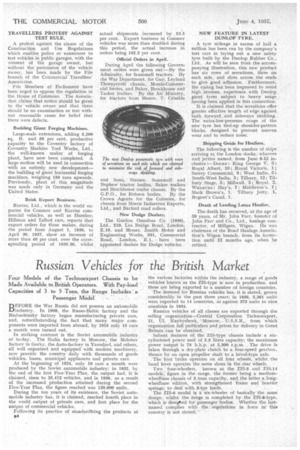Russian Vehicles for the British Market
Page 38

If you've noticed an error in this article please click here to report it so we can fix it.
Four Models of the Technoexport Chassis to be Made Available to British Operators. With Pay-load Capacities of 3 to 5 Tons, the Range Includes. a Passenger Model BEFORE the War Russia did not possess an automobile industry. In 1908, the Russo-Baltic factory and the Riabushinsky factory began manufacturing private cars, and, notwithstanding the fact that many major components were imported from abroad, by 1915 only 15 cars a month were turned out.
In striking contrast is the Soviet automobile industry of to-day. The Stalin factory in Moscow, the Molotov factory in Gorky, the Auto-factory in Yaroslavl, and others, all well -organized and equipped with modern machinery, now provide the country daily with thousands of goods vehicles, buses, municipal appliances and private cars.
At the beginning of 1924, only 10 cars a month were produced by the Soviet automobile industry; in 1932, by the end of the first Five-Year Plan, the output had, it is claimed, risen to 25,412 vehicles, and in 1936, as a result of the increased ptoduction attained during the second Five-Year Plan, the figure reached was 120,000 units.
During the ten years of its existence, the Soviet automobile industry has, it is claimed, reached fourth place in the world output of private cars, and first place for the output of commercial vehicles.
Following its practice of standardIzing the products of ia4
the various factories within the industry, a range of goods vehicles 'knoWrins the ZIS-type is"now in production, and these are being exported to a number of foreign countries. . The "demand -Ter Russian vehicles has., it is stated, grown considerably in the past three years; in 1936, 2,361 unith were exported to 14 countries, as against 373 units to nine countries in 1934.
Russian vehicles of all classes are exported through the selling organization—Central • Corporation Technoexport, 21, Ul. Knybyshev'a, '-Moscow,.. U.S.S.R., from which organization full •particulars and prices for delivery in Great Britain can. be obtained.
Salient features of, the ZIS-type chassis include • a sixcylindered power unit of 5.5 litres capacity; the maximum power output is 73 b.11:p.": at 2,300 r.p.•ni. The drive is taken through a dry-plate clutch to a four-speed gearbox, thence b an open propeller shaft to a bevel-type axle.
. The foot brake operates on all four Wheels, whilst. the hand lever operates the:same shoes in the rear wheels.
Two fourwheeIers, known as the ZIS5 and ZIS-14 models, figure in the range, the -former being a medium-. wheelbase chassis. of 3 .tons capacity, and the latter„
a long wheelbase edition, with strengthened frame and heavier springs, to deal with 5-ton loads. -• • .
The ZIS-6 model is a six-wheeler of basically-the. same design, whilst the range. is completed by -the ZIS-8-type, which is desigfied for passenger bodies Whether .the. last
named complies with the regulations force in' 'this country is not stated.




























































































